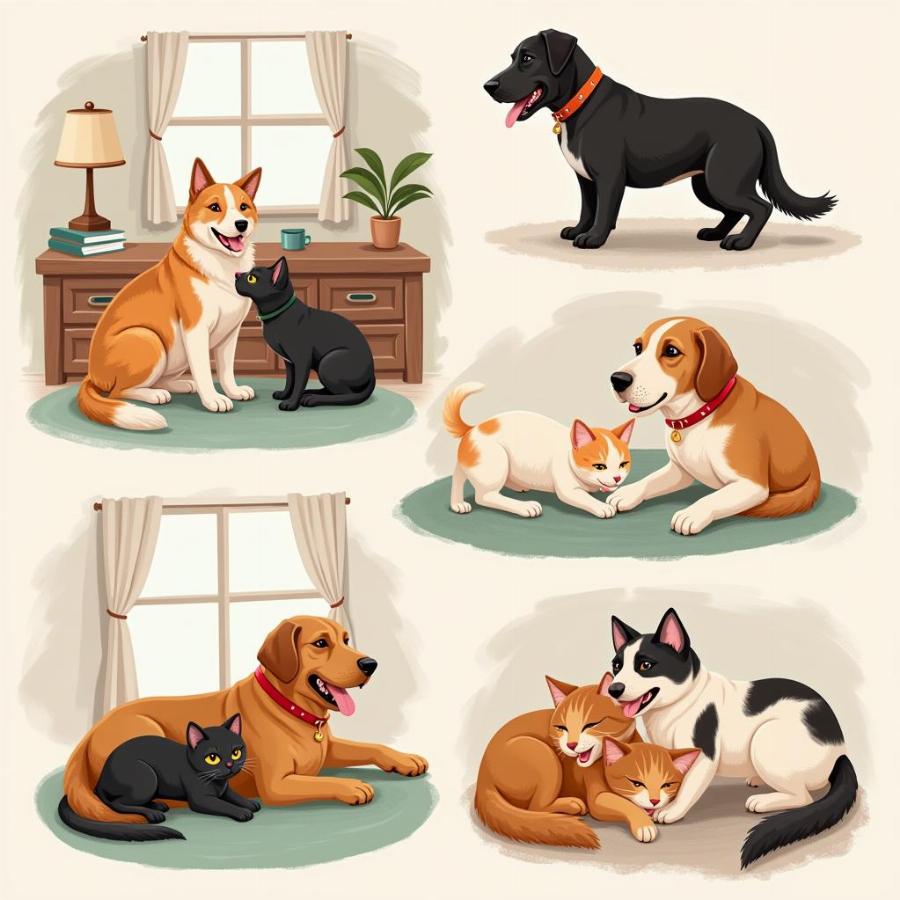The fascinating interplay between dogs and cats has intrigued pet owners for centuries. Understanding the nuances of “dog cat sound” – how dogs react to cat sounds, and vice-versa, can provide valuable insights into their interspecies communication and help create a harmonious multi-pet household. This article delves into the complex world of canine and feline acoustics, exploring how these sounds influence their interactions and what they reveal about their respective behaviors.
Dogs, known for their keen sense of hearing, are highly attuned to a variety of sounds, including the vocalizations of cats. A meow, hiss, or growl from a feline companion can trigger a range of reactions in a dog, from playful curiosity to wary alertness, or even aggression. The specific response often depends on the dog’s breed, temperament, prior experiences with cats, and the context of the sound itself. For instance, a playful meow might invite a playful chase, while a defensive hiss could signal a potential conflict. Understanding these subtle cues is crucial for owners of both dogs and cats.
How Dogs Interpret Cat Sounds
Dogs often perceive cat sounds as signals of potential prey, playmates, or threats. A high-pitched meow can trigger a dog’s predatory instincts, leading them to chase the cat. Conversely, a low growl can be interpreted as a warning, prompting the dog to either approach cautiously or back away. This complex interplay of sound and behavior highlights the intricate communication between these two species.
The Impact of Cat Sounds on Dog Behavior
The impact of cat sounds on dog behavior is significant and multifaceted. A sudden hiss or growl can startle a dog, causing it to jump or bark. Repeated exposure to these sounds can either lead to habituation, where the dog learns to ignore them, or to sensitization, where the dog becomes increasingly reactive. Understanding this dynamic is crucial for managing interactions and preventing potential conflicts.
The Role of Dog Sounds in Inter-species Communication
While the focus is often on how dogs react to cat sounds, dog vocalizations also play a crucial role in their interspecies communication. A dog’s bark, whine, or growl can convey a variety of messages to a cat, ranging from playful invitation to aggressive warning. Cats, being astute observers, quickly learn to interpret these signals, adapting their behavior accordingly.
How Cats Perceive Dog Sounds
Cats, with their exceptional hearing, can easily discern different dog vocalizations. A playful bark might be met with curiosity or indifference, while a loud, aggressive bark can trigger fear or a defensive posture. This intricate dance of sound and response underscores the subtle yet powerful ways in which dogs and cats communicate.
Creating Harmony in a Multi-Pet Home
Understanding the intricacies of “dog cat sound” is essential for fostering a peaceful coexistence between dogs and cats. Proper introductions, positive reinforcement training, and creating separate spaces for each pet can significantly reduce tension and promote harmonious interactions. cat sounds for dogs can be used for desensitization training, helping dogs become accustomed to cat vocalizations and reducing their reactivity.
Tips for Managing Dog-Cat Interactions
- Supervise initial interactions: Closely monitor early encounters to prevent any aggressive behavior.
- Positive reinforcement: Reward calm and friendly behavior with treats and praise.
- Separate spaces: Provide each pet with their own designated area where they can retreat and feel safe.
- Desensitization training: Gradually expose your dog to recorded cat sounds, starting at a low volume and gradually increasing it as the dog becomes more comfortable. cat sounds and dog sounds resources can be beneficial.
- Consult a professional: If you’re struggling to manage interspecies conflicts, seek guidance from a certified dog trainer or animal behaviorist.
 Cats and Dogs Living in Harmony
Cats and Dogs Living in Harmony
Conclusion
The world of “dog cat sound” is a complex and fascinating one. By understanding how dogs and cats perceive and react to each other’s vocalizations, we can gain valuable insights into their interspecies communication and create a more harmonious environment for our beloved pets. Remember, patience, understanding, and consistent training are key to fostering a peaceful multi-pet household.
FAQ
- Why does my dog bark at my cat’s meow? This could be due to prey drive, territoriality, or simply surprise.
- How can I stop my dog from chasing my cat? Consistent training, positive reinforcement, and creating separate spaces can help.
- Do cats understand dog barks? Yes, cats are very perceptive and can interpret different dog vocalizations.
- Can dogs and cats live together peacefully? Absolutely, with proper introductions and management.
- What should I do if my dog and cat fight? Separate them immediately and consult a professional.
- How do I introduce a new dog to a resident cat? Slowly and gradually, using positive reinforcement and separate spaces.
- Are there any resources for cat sounds that can help with dog training? Yes, you can find resources online, like squeaky balls for dogs, which can be used for desensitization training.
Beaut Dogs is your trusted source for all things canine, offering expert advice and valuable resources for dog owners. For further assistance and personalized guidance, please contact us at Email: [email protected]. Beaut Dogs is committed to helping you navigate the wonderful world of dog ownership.